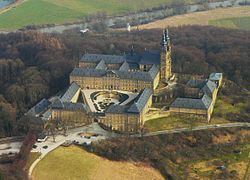Other names Schloss Banz Established ca. 1070 Style Baroque | Order Benedictine Disestablished 1803 | |
 | ||
Architect Anselm Franz von Ritter zu Groenesteyn Similar Basilica of the Fourteen, Staffelberg, Veste Coburg, Obermain Therme, Schloss Seehof | ||
Bodo wartke regen songs an einem sommerabend 2006
Banz Abbey (German: Kloster Banz), now known as Banz Castle (German: Schloss Banz), is a former Benedictine monastery, since 1978 a part of the town of Bad Staffelstein north of Bamberg, Bavaria, southern Germany.
Contents
History
The abbey was founded in about 1070 by Countess Alberada of Schweinfurt and her husband, Count Hermann of Habsburg-Kastl, and until the secularisation of 1803 was the oldest monastery on the upper Main.
In the late Middle Ages and until 1575 only members of the nobility were accepted as monks.
After the Thirty Years' War the abbey had to be rebuilt. The abbots Eucharius Weiner and Kilian Düring commissioned Johann Leonhard Dientzenhofer and after his death in 1707, his brother Johann Dientzenhofer. Construction began in 1698. The church, built in of Baroque style, was consecrated in 1719. The interior is built, not with right angles, but with a series of ellipses. The main altar, the chancel and the statues of saints in the church and on the facade are by Balthasar Esterbauer; the ceiling frescoes are by Melchior Steidl. The choir stalls were made by the court cabinet maker and ebonist of Schönborn, Johann Georg Nesstfell.
In the second half of the 18th century Banz Abbey was known throughout the Holy Roman Empire as a place of Catholic enlightenment and for the scholarship of its monks. This did not save it from secularisation and dissolution in 1803.
After dissolution
In 1813 Duke Wilhelm in Bavaria, acquired the former abbey premises, which were thereafter known as Schloss Banz ("Banz Castle").
In 1933 Duke Ludwig Wilhelm in Bavaria, sold the buildings to the Community of the Holy Angels ("Gemeinschaft von den heiligen Engeln"), an order dedicated to the spiritual care of expatriate Germans. Since 1978 the former monastery has been in the possession of the Hanns Seidel Foundation, an organisation closely associated with the political party CSU, and is used as a conference centre. It also accommodates a collection of fossils and other curiosities, such as Egyptian mummies.
The estate of the former monastery, including vast forests, is today owned by Duke Max Emanuel's eldest daughter Sophie, Hereditary Princess of Liechtenstein.
